Here’s your Tuesday moment of zen, courtesy of César Sánchez’s Twisted Bacteria blog:
Captured in this time-lapse video taken by one Nick Lariontsev (see here for pictures of the camera setup) is a sampler of fungal growth. In a few cases, it begins with single spores, which would require higher magnification to see. Then, individual fungal threads, or hyphae, sprout and branch in all directions, crossing and recrossing each other. Finally, the group of hyphae becomes a full-fledged mycelium (my-SEAL-ee-um), and then inflates or pinches off certain tips to make spores and sporangia, or spore houses. When the mold changes color from a distance, it is because it is producing colored spores with sunscreen.
You should think of these white fuzzy masses not in sterile petri plates, but in nature. When you turn over a log and see a white mat underneath, you are seeing these filaments. When a fungus attacks a tree, the filaments infiltrate the tree’s cells with a prickly, probing fingers. And when a fungus partners with a tree as a mycorhiza, its hyphae (high-fee) wrap around or penetrate the root — all the way through cell walls to the cell membranes, where they stop so as not to harm the tree. And of course, when takeout spends a bit too long at the Frigidaire spa, it too feels the caress of fungi.
Finally, you see fungus mites briefly at about 3:22, and then again at the very end, where they’re mowing down mold like cows that got into the corn field. In the comments at César’s post, Psi Wavefunction comments that in order to terrorize a mycologist, all one has to do is point and shout “fungus mite!”. I don’t recall every having troubles with them when I was in school, but I can easily believe it. I’ve had enough trouble with aphids and powdery mildews on my plants . . .
Mites are arachnids like spiders and ticks. In fact, mites are in the same taxon (Acari) as ticks. Here’s a close-up of the fungus mites featured in our film:
As for the molds, I don’t know which mold species are which, exactly, except that the tiny black pinheads are probably Mucor, and the grey stuff is likely Botrytis. But for what it’s worth, here are close-ups of conidiophores and conidia (asexual spore houses and spores) of the fungi the author names in the notes as the subjects of the film. All of these molds are extremely common in the environment. Odds are you are breathing in a few of their spores at this very moment. And it’s not cause for panic. Mold spores are everywhere.
Aspergillus fumigatus
Botrytis sp. — so named for the grape-like clusters of spores, and also called “grey mold” for its outward appearance. Ironically, it is also used to produce extremely sweet dessert wines referred to as “Botrytized”. The Germans call it “Trockenbeerenauslese”. Of course.
Mucor — the only zygomycete here. Conidia are housed in a sporangium that looks like a Q-tip (sorry — “cotton swab”).
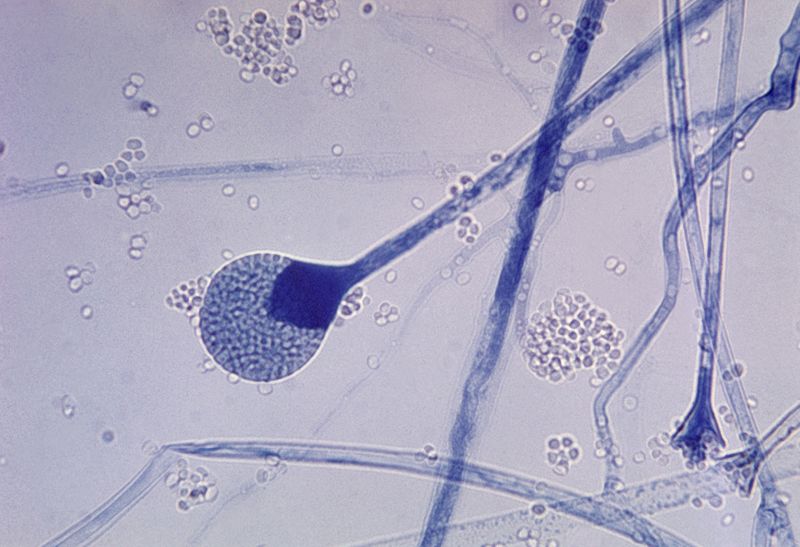
US Department of Agriculture, Agricultural Research Service, Systematic Botany and Mycology Laboratory
Trichoderma. Conidia (asexual spores) are at tips of “phialades”. They blow them up like balloons. In the photo below you can see them in various stages of inflation.
Cladosporium

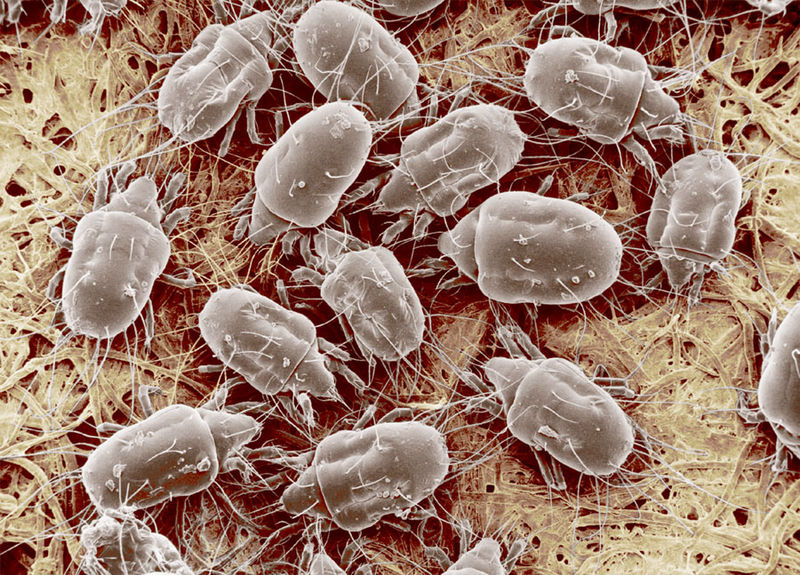
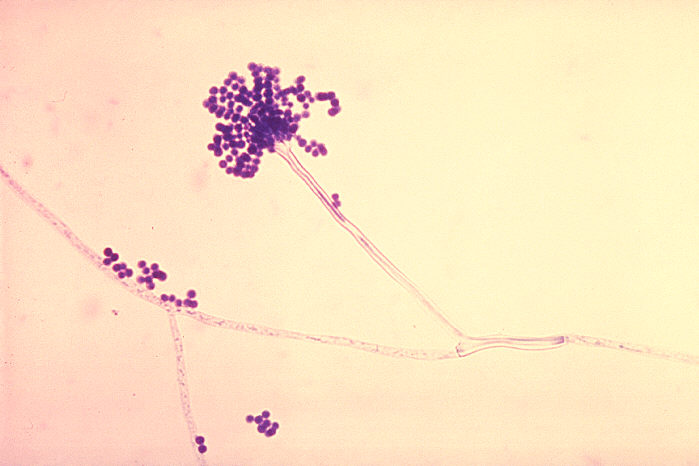

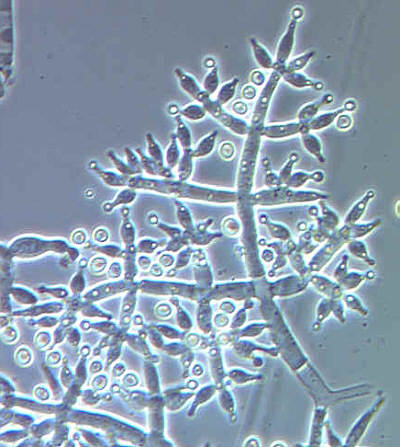
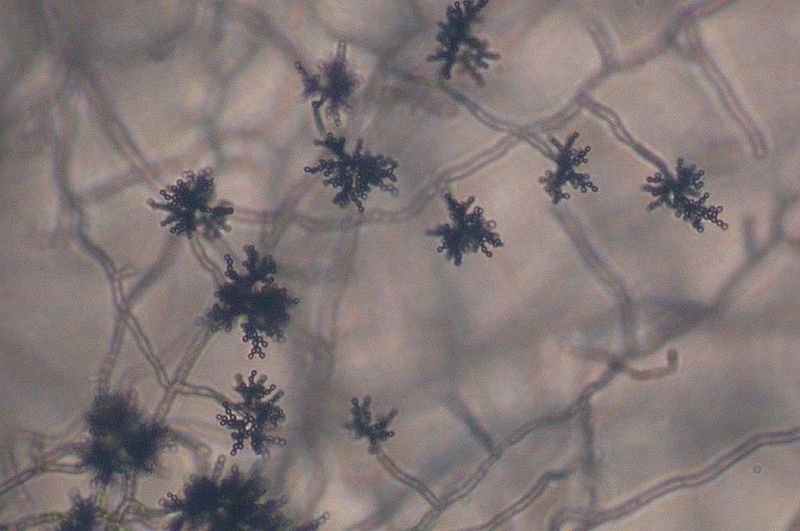

{ 3 trackbacks }
{ 9 comments… read them below or add one }
Sunscreen?! Is the process similar (or homologous) to melanin production in human skin?
I love your blog—thank you for the beautiful, clear writing and gorgeous images.
About 25 years ago Nature, the TV program, had a time-lapse video of fungi of various sorts called “The Rotten World Around Us”. It starts with a bowl of fresh fruit that decomposes before you eyes. Great stuff.
Great video.. and I love that mite photo. Feels very sci fi. I blogged on fungus today as well. Micor, to be precise. Must be in the air .. so to speak.
Ok, so I can’t type .. that would be Mucor …
Hi! You might find this http://icelines.blogspot.com/2011/06/tuesday-poem-gromiadna-silent-creature.html interesting.
Well, it’s about tiny critters (protists) in strange places!
Kathryn — Yes! In fact, fungi (as well as many other groups of organisms) use the group of chemicals called melanins. In addition to providing UV protection, melanins actually seem to help pathogenic fungi attack and invade their hosts. Pretty amazing stuff! Coincidentally, if you live out west, melanins in the fungi carried by mountain pine beetles are what stains the lodgepole pine wood “blue”. Somehow, brown/black melanin looks blue in yellow wood . . .
For more info see
http://www.ncbi.nlm.nih.gov/pubmed/12734441
http://en.wikipedia.org/wiki/Melanin#In_other_organisms
http://www.plosone.org/article/info:doi%2F10.1371%2Fjournal.pone.0002993
http://www.sciencedirect.com/science/article/pii/S1049964404001586#secx10
http://www.genomealberta.ca/blogs/main_05090801.aspx
It appears there may even be fungi that use melanins as radiosynthetic pigments to convert gamma rays to food in the abandoned Chernobyl power plant!
http://en.wikipedia.org/wiki/Radiotrophic_fungus
I had no idea there were autotrophic fungi until I started looking into this . . .
It looks like even slime molds have gotten in on the melanin action . . .
http://www.sciencedirect.com/science/article/pii/S095375628980067X
Dina and Kimberly — Interesting. Thanks!
Awesome post. Love it.
Great post! Your video was super helpful in my entry yesterday. Glad to find this blog as well; mycology has been quickly rising to the top of favorite things, beside plant pathology and science writing.
Thanks! Cool stuff.